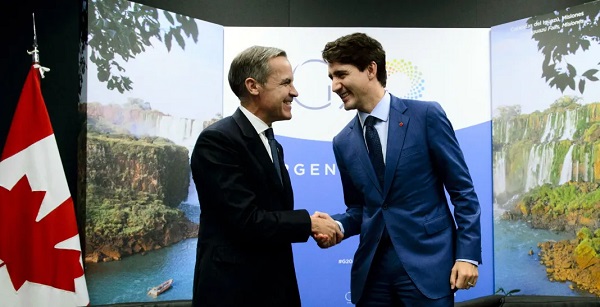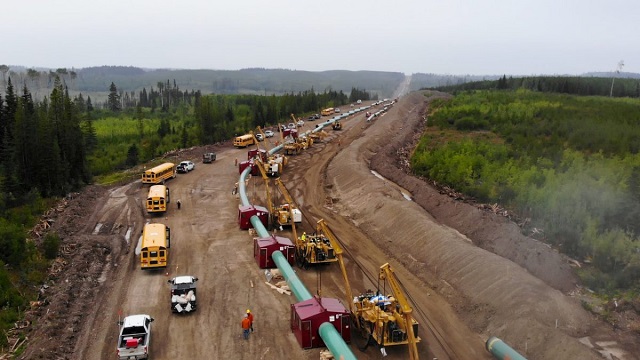Energy
Canadian Gas Association Writes a Letter to Prime Minister Justin Trudeau Highlighting the Importance of Natural Gas Energy Choice for Canadians

From EnergyNow.ca
On January 29, 2024, the Canadian Gas Association (CGA) sent a letter to Prime Minister Justin Trudeau, emphasizing the significance of the natural gas energy option for Canadians, a need underscored by the recent severe weather conditions in Western Canada.
The letter reads as follows:
Canada’s energy delivery companies had their work cut out for them over the last few weeks, ensuring the country could get through a period of extreme cold temperatures. The polar vortex that locked in across the continent only underscored how important an energy system with many options is to our overall well-being. I thought I would expand on this point in my first letter to you in 2024.
The second week of January saw temperatures in parts of the country drop well into the minus 40s, with windchill in the minus 50s. This triggered alerts from various authorities to reduce electricity use. Around 4 pm in Alberta on January 12th wind and solar generation facilities were operating at only a few percentage points of their capacity. But power was desperately needed. Luckily, a combination of in-province and neighbouring jurisdiction power sources – like natural gas-powered plants – could help meet the power needs of the province.
It is worth drawing attention to the fact that the alerts were all about a single energy system – the electricity grid. While that grid was under strain due in part to low renewable energy generation availability, the natural gas delivery system (a separate system that delivers gas energy, not electrons) was delivering approximately 9 times the energy and operating without any alerts required.
The contribution of the gas system is really worth emphasizing.
Nationally, over an average year, electricity meets just over 20% of our energy needs. Natural gas directly delivered to customers – residential, commercial and industrial – meets almost twice that amount, or just under 40% and liquid fuels like gasoline and diesel meet the balance. But at certain times of the year, such as during the recent January freeze, the differential between what natural gas and electricity deliver grows dramatically. At points earlier this month Alberta had use of roughly 12,000 megawatts of electric power and over 110,000 megawatts of gas energy equivalent.
And yet it was the electric system, not the natural gas system, that was threatened.
Media coverage during and after the freeze referenced how the electric system is threatened by extreme weather and needs to be built out to meet demand. But to suggest that the electric system could ever meet the energy delivered by natural gas over the gas delivery system is simply unrealistic. Do those who advocate for the electrification of all energy, especially peak heating needs, pretend that we have either the means, the resources, or the dollars, to build out an electric system that could meet roughly nine times the load of the gas system? Do advocates of natural gas bans appreciate that banning natural gas power generation would leave us in situations of actual shortage – a terrifying spectacle in the event of minus 50 degree weather?
Again, the point here is to underscore the value proposition of natural gas and the infrastructure that delivers it: the reliability these provide is extraordinarily important. This value is particularly well demonstrated when severe weather – a Canadian reality – hits us. We have to stop talking about eliminating the choice of energy options like natural gas, and relying exclusively on one energy delivery system, like electricity. Each delivery system has its own advantages, and natural gas is particularly well suited to meet heating needs. That should never be overlooked, as this month’s weather events reminded us.
Prime Minister, when it comes to energy – in supply options, and in delivery systems – diversity truly is our strength in Canada. We must maintain natural gas as an option for reliability, for affordability, and for sustainability – all of which are essential for our country’s energy security and the wellbeing of the Canadian consumer.
Respectfully,
Timothy M. Egan
President and CEO, Canadian Gas Association
Chair, NGIF Capital Corporation
About CGA
The Canadian Gas Association (CGA) is the voice of Canada’s gaseous energy delivery industry, including natural gas, renewable natural gas (RNG) and hydrogen. CGA membership includes energy distribution and transmission companies, equipment manufacturers, and suppliers of goods and services to the industry. CGA’s utility members are Canadian-owned and active in eight provinces and one territory. The Canadian natural gas delivery industry meets 38 per cent of Canada’s energy needs through a network of almost 584,000 kilometers of underground infrastructure. The versatility and resiliency of this infrastructure allows it to deliver an ever-changing gas supply mix to 7.6 million customer locations representing approximately two-thirds of Canadians. CGA members ensure Canadians get the affordable, reliable, clean gaseous energy they want and need. CGA is also working to constantly improve that gaseous energy offering, by driving forward innovation through the Natural Gas Innovation Fund (NGIF).
SOURCE Canadian Gas Association
Carbon Tax
Carney fails to undo Trudeau’s devastating energy policies

From the Fraser Institute
By Tegan Hill and Elmira Aliakbari
On the campaign trail and after he became prime minister, Mark Carney has repeatedly promised to make Canada an “energy superpower.” But, as evidenced by its first budget, the Carney government has simply reaffirmed the failed plans of the past decade and embraced the damaging energy policies of the Trudeau government.
First, consider the Trudeau government’s policy legacy. There’s Bill C-69 (the “no pipelines act”), the new electricity regulations (which aim to phase out natural gas as a power source starting this year), Bill C-48 (which bans large oil tankers off British Columbia’s northern coast and limit Canadian exports to international markets), the cap on emissions only from the oil and gas sector (even though greenhouse gas emissions have the same effect on the environment regardless of the source), stricter regulations for methane emissions (again, impacting the oil and gas sector), and numerous “net-zero” policies.
According to a recent analysis, fully implementing these measures under Trudeau government’s emissions reduction plan would result in 164,000 job losses and shrink Canada’s economic output by 6.2 per cent by the end of the decade compared to a scenario where we don’t have these policies in effect. For Canadian workers, this will mean losing $6,700 (annually, on average) by 2030.
Unfortunately, the Carney government’s budget offers no retreat from these damaging policies. While Carney scrapped the consumer carbon tax, he plans to “strengthen” the carbon tax on industrial emitters and the cost will be passed along to everyday Canadians—so the carbon tax will still cost you, it just won’t be visible.
There’s also been a lot of buzz over the possible removal of the oil and gas emissions cap. But to be clear, the budget reads: “Effective carbon markets, enhanced oil and gas methane regulations, and the deployment at scale of technologies such as carbon capture and storage would create the circumstances whereby the oil and gas emissions cap would no longer be required as it would have marginal value in reducing emissions.” Put simply, the cap remains in place, and based on the budget, the government has no real plans to remove it.
Again, the cap singles out one source (the oil and gas sector) of carbon emissions, even when reducing emissions in other sectors may come at a lower cost. For example, suppose it costs $100 to reduce a tonne of emissions from the oil and gas sector, but in another sector, it costs only $25 a tonne. Why force emissions reductions in a single sector that may come at a higher cost? An emission is an emission regardless of were it comes from. Moreover, like all these policies, the cap will likely shrink the Canadian economy. According to a 2024 Deloitte study, from 2030 to 2040, the cap will shrink the Canadian economy (measured by inflation-adjusted GDP) by $280 billion, and result in lower wages, job losses and a decline in tax revenue.
At the same time, the Carney government plans to continue to throw money at a range of “green” spending and tax initiatives. But since 2014, the combined spending and forgone revenue (due to tax credits, etc.) by Ottawa and provincial governments in Ontario, Quebec, British Columbia and Alberta totals at least $158 billion to promote the so-called “green economy.” Yet despite this massive spending, the green sector’s contribution to Canada’s economy has barely changed, from 3.1 per cent of Canada’s economic output in 2014 to 3.6 per cent in 2023.
In his first budget, Prime Minister Carney largely stuck to the Trudeau government playbook on energy and climate policy. Ottawa will continue to funnel taxpayer dollars to the “green economy” while restricting the oil and gas sector and hamstringing Canada’s economic potential. So much for becoming an energy superpower.
Business
Large-scale energy investments remain a pipe dream

I view the recent announcements by the Government of Canada as window dressing, and not addressing the fundamental issue which is that projects are drowning in bureaucratic red tape and regulatory overburden. We don’t need them picking winners and losers, a fool’s errand in my opinion, but rather make it easier to do business within Canada and stop the hemorrhaging of Foreign Direct Investment from this country.
Thanks for reading William’s Substack!
Subscribe for free to receive new posts and support my work.
Changes are afoot—reportedly, carve-outs and tweaks to federal regulations that would help attract investment in a new oil pipeline from Alberta. But any private proponent to come out of this deal will presumably be handpicked to advance through the narrow Bill C-5 window, aided by one-off fixes and exemptions.
That approach can only move us so far. It doesn’t address the underlying problem.
Anyone in the investment world will tell you a patchwork of adjustments is nowhere near enough to unlock the large-scale energy investment this country needs. And from that investor’s perspective, the horizon stretches far beyond a single political cycle. Even if this government promises clarity today in the much-anticipated memorandum of understanding (MOU), who knows whether it will be around by the time any major proposal actually moves forward.
With all of the talk of “nation-building” projects, I have often been asked what my thoughts are about what we must see from the federal government.
The energy sector is the file the feds have to get right. It is by far the largest component of Canadian exports, with oil accounting for $147 billion in 2024 (20 percent of all exports), and energy as a whole accounting for $227 billion of exports (30 percent of all exports).
Furthermore, we are home to some of the largest resource reserves in the world, including oil (third-largest in proven reserves) and natural gas (ninth-largest). Canada needs to wholeheartedly embrace that. Natural resource exceptionalism is exactly what Canada is, and we should be proud of it.
One of the most important factors that drives investment is commodity prices. But that is set by market forces.
Beyond that, I have always said that the two most important things one considers before looking at a project are the rule of law and regulatory certainty.
The Liberal government has been obtuse when it comes to whether it will continue the West Coast tanker ban (Bill C-48) or lift it to make way for a pipeline. But nobody will propose a pipeline without the regulatory and legal certainty that they will not be seriously hindered should they propose to build one.
Meanwhile, the proposed emissions cap is something that sets an incredibly negative tone, a sentiment that is the most influential factor in ensuring funds flow. Finally, the Impact Assessment Act, often referred to as the “no more pipelines bill” (Bill C-69), has started to blur the lines between provincial and federal authority.
All three are supposedly on the table for tweaks or carve-outs. But that may not be enough.
It is interesting that Norway—a country that built its wealth on oil and natural gas—has adopted the mantra that as long as oil is a part of the global economy, it will be the last producer standing. It does so while marrying conventional energy with lower-carbon standards. We should be more like Norway.
Rather than constantly speaking down to the sector, the Canadian government should embrace the wealth that this represents and adopt a similar narrative.
The sector isn’t looking for handouts. Rather, it is looking for certainty, and a government proud of the work that they do and is willing to say so to Canada and the rest of the world. Foreign direct investment outflows have been a huge issue for Canada, and one of the bigger drags on our economy.
Almost all of the major project announcements Prime Minister Mark Carney has made to date have been about existing projects, often decades in the making, which are not really “additive” to the economy and are reflective of the regulatory overburden that industry faces en masse.
I have always said governments are about setting the rules of the game, while it is up to businesses to decide whether they wish to participate or to pick up the ball and look elsewhere.
Capital is mobile and will pursue the best risk-adjusted returns it can find. But the flow of capital from our country proves that Canada is viewed as just too risky for investors.
The government’s job is not to try to pick winners and losers. History has shown that governments are horrible at that. Rather, it should create a risk-appropriate environment with stable and capital-attractive rules in place, and then get out of the way and see where the chips fall.
Link to The Hub article: Large-scale energy investments remain a pipe dream
Formerly the head of institutional equity research at FirstEnergy Capital Corp and ATB Capital Markets. I have been involved in the energy sector in either the sell side or corporately for over 25 years
Thanks for reading William’s Substack!
Subscribe for free to receive new posts and support my work.
-

 Carbon Tax1 day ago
Carbon Tax1 day agoCarney fails to undo Trudeau’s devastating energy policies
-

 Business1 day ago
Business1 day agoBudget 2025: Ottawa Fakes a Pivot and Still Spends Like Trudeau
-

 armed forces2 days ago
armed forces2 days agoCanada At Risk Of Losing Control Of Its Northern Territories
-

 Health1 day ago
Health1 day agoTens of thousands are dying on waiting lists following decades of media reluctance to debate healthcare
-

 International2 days ago
International2 days agoCanada’s lost decade in foreign policy
-

 Opinion1 day ago
Opinion1 day agoLandmark 2025 Study Says Near-Death Experiences Can’t Be Explained Away
-

 Focal Points1 day ago
Focal Points1 day agoSTUDY: TikTok, Instagram, and YouTube Shorts Induce Measurable “Brain Rot”
-

 International2 hours ago
International2 hours ago“The Largest Funder of Al-Shabaab Is the Minnesota Taxpayer”










